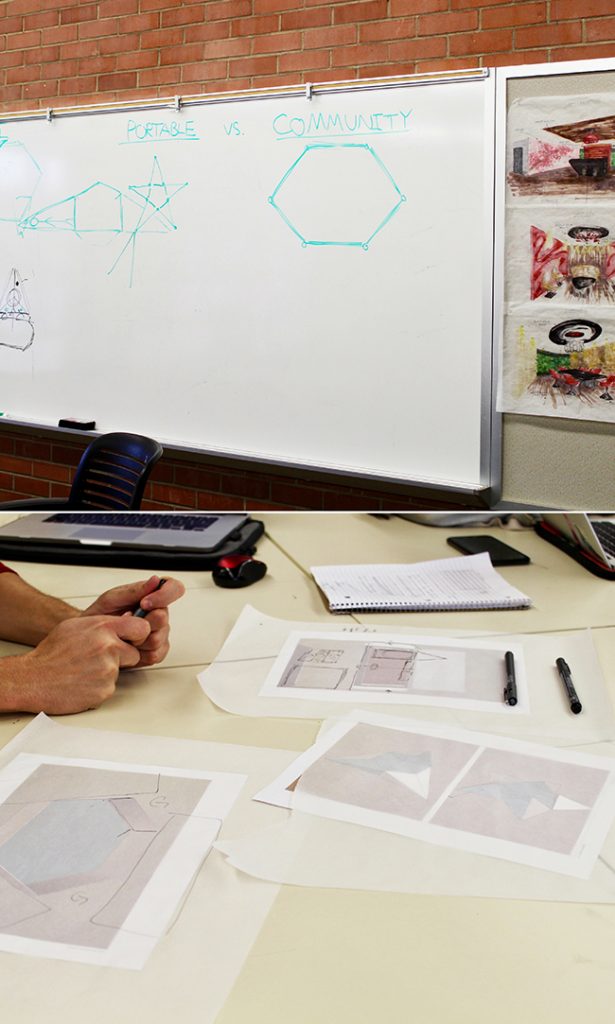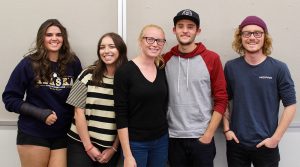By Heidi Toth
NAU Communications
Termites have to keep their larva at a cool temperature before hatching, so living in forests, basements and other dark, cool spaces makes sense.
Living in the Sahara Desert, where summer temperatures can soar past 115 degrees for days on end, does not make sense.
Yet the bugs not only live in the desert, they thrive, with the same tool humans use to make living in the desert possible—air conditioning. Using only dirt and their own spit, the insects build a natural cooling system into their mounds, allowing the inside to remain at a temperature low enough for the larva to develop despite the bracing summer sun.
Northern Arizona University senior Tristan Hess, who is studying interior design, learned about termite engineering in a construction management class. Now-retired professor Stephen Mead talked about a building in Zimbabwe modeled somewhat after a termite mound, complete with this natural ventilating system. This process, Mead told his students, is known as biomimicry—copying nature to build structures, design software or create medicine.
“I just thought it was so cool, this idea of modeling something after nature and using it for your own benefit,” Hess said. “So I started doing my own research on it.”
A couple of weeks later, he was sitting in an interior design class when the professor mentioned biomimicry. With his research fresh in his mind, he approached after class and told her of his interest in this concept. Was there some way for him to put this research into practice and get credit for it?
There was. This semester Hess began a yearlong independent study, during which time he will research biomimicry and bioinspiration and then design and build a prototype of his project—a homeless shelter that can withstand Flagstaff winters, be lightweight and movable and not cost too much to make. He also won a Hooper Undergraduate Research Award from NAU and will present his research at the Undergraduate Symposium in April.
And if that wasn’t enough to motivate Hess in his final year at NAU, he has the responsibility of leading a team of students and networking with architects, designers and city leaders to get buy-in for a project that he hopes goes far beyond his prototype.
“This really changes the game and brings new ideas,” he said.
Natural inspiration
In a climate-controlled world in which needs are scheduled weeks in advance, a shelter for homeless populations or refugees would be as simple as four walls and a roof. No creativity or extra effort would be needed.
Flagstaff is not that world. A shelter here needs to offer protection from the elements and low temperatures. Hess also envisions the shelter being built in pieces that are easy to put together and take apart as well as easy to move, as these could be used after natural disasters where temporary shelters are needed quickly or in refugee camps.

Could that ideal shelter be a simple tent-like structure that looks the same as tents anywhere else? Sure. But that may not be the best option, and that is what Hess wants to know.
“I think one of the really successful pieces of his proposal is it’s going to force anyone who gets involved with this project to think from a new direction,” said Britton Shepardson, an anthropology lecturer who is an adviser on Hess’ project. “If we really want to come up with something new, let’s force ourselves to be inspired by something totally different and off the wall.”
Shepardson has a history of being inspired by the totally different. One day after class, Hess went by Shepardson’s office to see the hydroponic garden in the window. The garden is engineered using tennis ball cans; Shepardson, an archaeologist, has gotten used to repurposing whatever is available after 15 years of nonprofit education work on the remote Easter Island. Hess, in the midst of research on the best ways to build a simple structure using whatever was available, told Shepardson about his project.
“I’ve known about biomimicry for the better part of a decade, but I was really impressed that an undergraduate student was knowledgeable about the world of biomimicry,” Shepardson said. He was in.
As the founder of a nonprofit, he brought administrative knowledge and connections to the group, introducing Hess to architects and designers and suggesting ways to obtain grants and work with government officials. He also liked approaching problems from a less traditional angle, particularly those that were well outside his field of study.
That is how Shepardson found himself making a long drive through the Mojave Desert thinking about Hess’ research. What if, he asked himself, they used what he called the Tinker Toy approach? Tinker Toys are building toys that clip together. They could design those clips as spherical joints that could have PVC pipe or some other material clip in, thus creating a modular exoskeleton from which heavy-duty tarps could be hung. The joints could be made easily, such as through the use of a 3-D printer, and PVC pipe and tarps are available anywhere.
This would also allow for structures to be sized differently with the same spherical joints and replicated easily if they could be made with 3-D printers. They would be easy to build and take down but still structurally sound enough to be safe and effective.
That, however, is the mathematical answer to the question of how. It’s important, but before Hess designs what he’s building he needs to figure out what he’s building.
Shepardson had an idea for that too.
“I don’t know how I know this, but sea stars, to eat, expel their entire stomach and engulf their prey, then draw their stomach back in with their prey,” he said.
What?
The idea they came up with was this: The tent would have a sack hanging in the interior of the tent made of some type of absorbent material. During the day, that sack would be pushed through the ceiling to the exterior of the tent, allowing it to absorb radiant heat as long as the sun was up. At night, it would retract into the tent and act as a natural heater.
Still—what?
In his ruminating, Hess took the sea star concept even further, sketching out a tent shaped like a star, with each arm serving as a private room and the center being a gathering place. With that, Shepardson said, they could consider using the exterior walls of the tent for freshwater bins, to grow gardens or place additional heat reservoirs. With nature, the possibilities are almost endless.
But at the end of the day, will this work? As the research continues, they’ll find out.
“Will it work,” though, is not the only question. It may be a total failure. That’s a normal part of the research process. Hess and his

team are learning how to research, design, plan and consider all of their options. They didn’t say no to anything because it was too weird.
“We want to really make an impact instead of just doing something repeated that isn’t going to be really beneficial,” Hess said. “That really changes the game of everything and brings new ideas.”
They haven’t settled on the sea star design; Hess and the other students are still researching their options and discussing ideas like anthills, looking beyond the engineering into how ants interact with society. In the spring they’ll start with the design, eventually designing a small-scale model that can be printed in 3-D that Hess will present at the Undergraduate Symposium in April.
Faculty or students who are interested in participating are welcome to join the team as well. Hess said they are looking for people in engineering and architecture especially.
The importance of undergraduate research
Hess is one of 36 students to earn a Hooper Undergraduate Research Award this year, which is one of NAU’s programs to encourage students to start research early. Tina Zecher, the senior program coordinator for the Office for Undergraduate Research and Scholarship, said the university encourages undergraduates to participate in research starting their first year of college, either by working with a professor on a project he or she has already started or, like Hess, creating a project of their own.
“It gives students the opportunity to apply what they’re learning in the classroom in a real-world setting,” she said. “In research, you actually see the purpose of what it is you’re doing.”
Although the benefit of research is obvious for students headed to graduate school, it also is valuable for those planning to enter the workforce after graduation. In addition to the networking that comes with working closely with researchers, students learn critical thinking and problem-solving skills, leadership, organization, communication skills and more.
The Office for Undergraduate Research and Scholarship, which administers the Hooper awards, has a number of other research programs as well, including providing funding for students to travel to present their research at conferences. Another is the Interns to Scholars program, which pays students to work with professors on their research. That is a good way to get students thinking about research without actually taking the lead on a research project, Zecher said.
Her department is working with academic departments to provide opportunities for even more undergraduate students to get into research, particularly younger students or those who don’t have research on their radar. It’s not just for science majors headed to graduate school, she said. All students in all disciplines can benefit from being involved in research.
“Research is for all students, and everyone is capable of it,” Zecher said. “Those who are less academically prepared have more to gain from being involved in a research experience.”
What are the Hooper Undergraduate Research Awards?
These awards, funded by Henry Hooper, a former vice president at NAU, provide undergraduate students up to $3,500 in a year to lead a research project. Students of all disciplines can apply and use the money to pay themselves to do the research, for materials and supplies or for travel, in case the project requires students to go into the field to gather data. Selected students get six hours of independent study credits and present their research at the symposium in April; they also attend a reception with Hooper. Applications for the next academic year can be submitted starting Feb. 1. All of the materials to apply for the Hooper Undergraduate Research Awards are available online.



